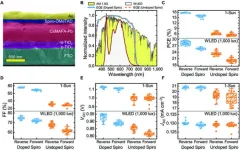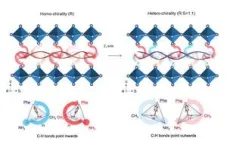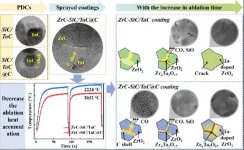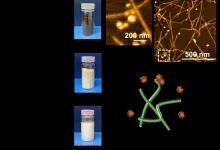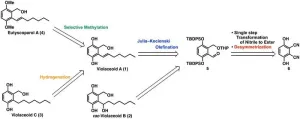Is doping of Spiro-OMeTAD a requirement for efficient and stable perovskite indoor photovoltaics?
2024-08-09
(Press-News.org) In this work, we study the outdoor and indoor photovoltaic performance of LHP-based devices utilizing Spiro-OMeTAD as the hole-transport material with commonly used dopants such as lithium bis(trifluoromethanesulfonyl)imide (Li-TFSI) or without any dopants. We find out that, despite the expected low performance of devices employing undoped Spiro-OMeTAD layer under 1-Sun illumination (up to 7.7% efficiency), the devices achieve up to 25.6% efficiency under 1000 lux illumination, which is comparable to the doped counterpart devices achieving up to 29.7% efficiency. This is mainly due to the major improvement in fill factor when going towards low-light intensities which can be explained by the diminished effect of series resistance under indoor lighting.
The operational stability of the devices was also tested. When kept under continuous white light illumination, undoped Spiro-OMeTAD devices also show ≈25% increase in maximum power point efficiency, thus potentially surpassing the performance of doped Spiro-OMeTAD devices. Undoped Spiro-OMeTAD devices also have lower hysteresis at very low-light levels and an open-circuit voltage of ≈0.65 V at 50 lux, thus making them more reliable in these conditions.
This work proposes that, despite the requirement of doped Spiro-OMeTAD to achieve high-performing LHP-based solar cells, the dopants may not be necessary to fabricate indoor photovoltaics that work reliably under low-light intensities with high efficiency and stability. The results also show that the efficiency of LHP-based solar cells do not predict their performance under low-light conditions thus the photovoltaic structure should be fine-tuned for the intended lighting source of the device to achieve the optimal performance.
END
ELSE PRESS RELEASES FROM THIS DATE:
2024-08-09
A research team led by the School of Engineering of the Hong Kong University of Science and Technology (HKUST) has constructed an unprecedented chiral-structured interface in perovskite solar cells, which enhances the reliability and power conversion efficiency of this fast-advancing solar technology and accelerates its commercialization.
A perovskite solar cell (PSC) is a type of solar cell that includes perovskite-structured compound materials, which are inexpensive to produce and simple to manufacture. Unlike conventional silicon solar cells that require expensive high-temperature, high-vacuum fabrication processes, perovskites can ...
2024-08-09
Boulder, Colo., USA: The Geological Society of America (GSA) is proud to announce the recipients of the 2024 GSA Awards, recognizing outstanding contributions to the geoscience community. Each awardee has demonstrated exceptional dedication, innovation, and impact in their respective fields.
GSA President’s Medal
Kathy Jefferson Bancroftis, a Paiute-Shoshone community leader and environmental protector, is honored for her advocacy and education on water misuse and environmental degradation in the Owens Valley, ...
2024-08-09
“GT is a fascinating evolutionary phenomenon observed in lower species and humans, albeit with differing impacts and mechanisms.”
BUFFALO, NY- August 9, 2024 – A new editorial was published in Oncoscience (Volume 11) on July 13, 2024, entitled, “Unveiling retrotransposon-derived DNA zip code for myeloma cell internalization.”
The complex interplay between extracellular genetic material and the tumor's genetic landscape presents a significant challenge in grasping cancer evolution, tumor genetic heterogeneity, and treatment response. Earlier research has revealed the role of circulating tumor DNA (ctDNA) in mediating the gene expression among ...
2024-08-09
ZrC has drawn wide attention as an anti-ablation coating material for lightweight C/C composites but is limited by the produced porous and loose ZrO2 film. To address this issue, the second phase is introduced to improve the densification of the formed Zr-X-O film. Such as ZrC-SiC/TaC coating, the produced low-melting-point oxides, SiO2 (Tm=1650 °C), Ta2O5 (Tm=1800 °C) and Zr6Ta2O17 (Tm=1900 °C), helped to form a dense oxides film. However, the high service temperature causes heat accumulation and a large thermal stress gradient on the surface of the coatings, which will result in large local defects and accelerate the failure of the coating. To decrease the ablation heat ...
2024-08-09
Fukuoka, Japan—The SDGs Design International Awards 2024 are calling for students worldwide to submit their original ideas for using design to achieve Sustainable Development Goals.
First organized in 2019 and led by Faculty of Design, Kyushu University, the awards aim to demonstrate the power of design in solving social problems and to elevate society's expectations for design.
Now in its sixth year, this year’s theme is “Let’s Create Sustainable Design for FOOD." ...
2024-08-09
Along with all the coffee we drink every day, over 6 million tons of spent coffee grounds are produced annually worldwide. Some of these grounds are reused as biofuel but the rest are disposed of in landfills. Over the last decade, research has focused on how to reuse these grounds. The primary focus has been on the polysaccharides from the cellulose and hemicellulose in the ground up coffee bean’s cell walls. Polysaccharides are used in composites, biopolymers, food packaging, construction materials and cellulose nanofibers (CNFs). CNFs specifically, which are cellulose reduced to nanoparticle size, 3 to 5 ...
2024-08-09
As the effects of a changing climate and other ecological insults compound, many coral reefs face severe perturbations and a generally poor prognosis for recovery. In an article published in BioScience's new "Perspective and Insight" category, Dr. Peter J. Edmunds of California State University, Northridge, argues for the continued monitoring of coral reefs, even when the seascapes they inhabit are in a significantly degraded state.
Drawing from his ongoing 37-year study in the US Virgin Islands, Edmunds argues that "only consistent, rigorous, and detail-oriented ...
2024-08-09
Rockville, MD (8/9/2024) – The AIM-HI Accelerator Fund today announces Margaret Foti, PhD, MD (hc), Chief Executive Officer of the American Association for Cancer Research (AACR), is selected unanimously by the 2024 Blue Ribbon Selection Committee as the recipient of the 2024 Beacon Award for Women Leaders in Oncology, from a pool of outstanding global nominees.
The Beacon Award for Women Leaders in Oncology was established in 2022 by the AIM-HI Accelerator Fund and sponsored by the National Foundation for Cancer Research (NFCR). The Beacon Award recognizes outstanding women leaders in health and life sciences who have significantly impacted cancer ...
2024-08-09
In a July 9 ceremony, Thomas Abbruscato, Ph.D., and Min Kang, Pharm.D., became the first recipients of the Douglas Stocco Research Chair, an endowment formerly known as the Texas Tech University Health Sciences Center’s (TTUHSC) Research Endowment. The Texas Tech University System Board of Regents officially renamed the endowed chair in late November 2023 and made two appointments available.
Abbruscato, professor and chair in the Department of Pharmaceutical Sciences at the TTUHSC Jerry H. Hodge School of Pharmacy, said it is an honor to receive the endowment.
“Personally, I am humbled to have ...
2024-08-09
The natural world is rich in chemical compounds with remarkable medicinal properties. A notable example is penicillin, discovered by chance from the Penicillium mold. This discovery revolutionized the treatment of bacterial infections and highlighted the potential of natural compounds in medicine. Since then, the identification, isolation, and synthesis of novel bioactive compounds from plants, fungi, and bacteria have become fundamental to drug development.
Recently, two groups of naturally occurring bioactive compounds have garnered significant attention: violaceoids A–F ...
LAST 30 PRESS RELEASES:
[Press-News.org] Is doping of Spiro-OMeTAD a requirement for efficient and stable perovskite indoor photovoltaics?
